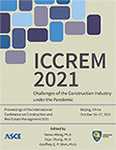Research on the Elastic Development of Spatial Layout of Hospitals Based on GIS Platform under COVID-19 Background: A Case Study of Wuhan
Publication: ICCREM 2021
ABSTRACT
COVID-19 has become a major public health emergency in the world. At the beginning of the outbreak of the COVID-19 epidemic, a series of medical squeezes appeared in Wuhan, which exposed the problems existing in the implementation of the hierarchical diagnosis and treatment system. Based on GIS platform, this paper analyzes the spatial layout of medical facilities at all levels in Wuhan and compares and analyzes the usage of daily and epidemic periods. It is found that the interlevel gap in the development of daily medical resources leads to spatial differences in the reserved development flexibility, showing the characteristics of weak elastic coping ability and low reserved development flexibility in the surrounding urban areas, strong elastic coping ability and high-reserved development flexibility in the central old urban area. Therefore, to improve the resilience of medical institutions at all levels, we should promote the balanced layout of primary medical institutions and the “decentralization” of high-level medical institutions in spatial layout, coordinate the number and organizational structure of medical resources at different levels, and implement differentiated allocation strategies.
Get full access to this article
View all available purchase options and get full access to this chapter.
REFERENCES
Cheng, M., and Lian, Y. J. (2018). “Spatial accessibility of urban medical facilities based on improved potential model: a case study of Yangpu District in Shanghai.” Progress in Geography, 37(02), 266–275. (in Chinese).
Ding, S., and Chen, B. Z. (2017) “Rationality assessment of the spatial distributions of urban medical facility.” Journal of Geo-information Science, 19(02), 185–196. (in Chinese).
Hu, R. X., and Chen, Z. N. (2008). “Research on spatial distribution of basic medical services in Guangzhou.” Yunnan Geographic Environment Research, (4), 48–53. (in Chinese).
Liu, Z., Yang, H. Y., Xiong, W. K., and Chen, G. H. (2017). “Spatial accessibilities of medical services at county level based on optimized two-step floating catchment area method.” Scientia Geographica Sinica, 37(05), 728–737. (in Chinese).
Liu, Z., and Yan, Y. L. (2020). “Institutional research of grading diagnosis and under the background of prevention and control of emergent outbreak.” China Health Law, 28(4), 18–21. (in Chinese).
Lu, Q. (2020). “Study on the cooperation in public health emergent crisis: taking COVID-19 as an example.” Academic Research, (4), 14–20. (in Chinese).
Ma, Q. W., Li, Y. H., and Deng, J. (2016). “Spatial layout and functional evaluation of medical facilities: Hong Kong special administrative region.” Planners, 32(05), 104–110. (in Chinese).
Qing, J. (2020). “Analysis on epidemic prevention and control mechanism of megacity: based on the predicament, effect and reconstruction of Wuhan’s combat COVID-19.” Journal of Hubei University (Philosophy and Social Science), 47(03), 21–32. (in Chinese).
Tao, X. L. (2019). “Research on the comprehensive reform of primary medical and health services under the hierarchical medical system: based in Wuhan.” Yangtze Tribune, (6), 40–45. (in Chinese).
Wu, F. M., Yuan, C., and Zheng, Z. P. (2015). “Research on hospital spatial pattern characteristic and its influence to emergency response of Chongqing.” Planners, 31(S1), 269–273. (in Chinese).
Zhang, L. F. (2020). “A study on the effective strategies of urban hierarchical medical system in the post-epidemic era.” Nanjing Journal of Social Sciences, (4), 7–13. (in Chinese).
Zhong, S. Y., Yang, X., and Chen, R. (2016). “The accessibility measurement of hierarchy public service facilities based on multi- mode network dataset and the two-step 2SFCA: a case study of Beijing’s medical facilities.” Geographical Research, 35(04), 731–744. (in Chinese).
Information & Authors
Information
Published In
Copyright
© 2021 American Society of Civil Engineers.
History
Published online: Dec 9, 2021
Authors
Metrics & Citations
Metrics
Citations
Download citation
If you have the appropriate software installed, you can download article citation data to the citation manager of your choice. Simply select your manager software from the list below and click Download.
